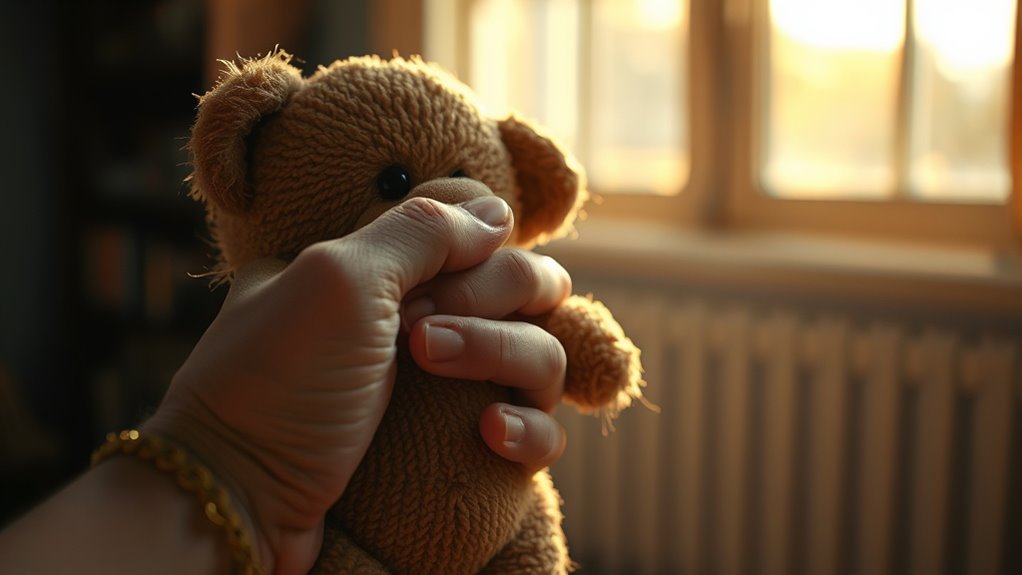Your attachment style from early life shapes how you handle emotions and relationships, which is where BPD symptoms often overlap. If you’ve experienced inconsistent caregiving, you might develop anxious or avoidant patterns that lead to intense mood swings, fear of abandonment, or emotional distance. These attachment patterns can reinforce feelings of emptiness and instability. Understanding this connection can help you recognize underlying causes of your struggles and find paths toward healing—exploring more reveals how to work through these patterns.
Key Takeaways
- Insecure attachment styles, especially anxious and avoidant, are common in individuals with BPD.
- Both attachment insecurities and BPD features involve emotional dysregulation and fear of abandonment.
- Early attachment disruptions contribute to the development of core BPD symptoms like instability and impulsivity.
- Attachment patterns influence relationship dynamics, often exacerbating BPD-related fears and trust issues.
- Therapy targeting attachment repair can improve BPD symptoms by fostering emotional stability and healthier relational patterns.

Attachment styles formed early in life play a significant role in the development of Borderline Personality Disorder (BPD). Your early relationships with caregivers shape how you perceive yourself and others, influencing how you handle emotions, trust, and intimacy later on. When attachment patterns are insecure or unstable during childhood, they can lay the groundwork for emotional dysregulation and relationship difficulties that are characteristic of BPD. For example, if you experienced inconsistent caregiving—sometimes feeling loved and supported, other times neglected or dismissed—you might develop an anxious or preoccupied attachment style. This can lead you to become overly dependent on others for validation, fearing abandonment even when your relationships seem stable.
On the other hand, if your caregivers were consistently unavailable or dismissive, you might have grown up with an avoidant attachment style. This often manifests as emotional distance and difficulty trusting others. You might suppress feelings or avoid intimacy altogether, which can fuel the core fears of rejection and abandonment found in BPD. These attachment patterns don’t just influence how you relate to others; they also impact your internal emotional landscape. For instance, an insecure attachment can leave you with a fragile sense of self, making you more prone to intense mood swings, impulsivity, and feelings of emptiness—all hallmark features of BPD.
The overlap between attachment styles and BPD becomes even clearer when you consider the way insecure attachments contribute to emotional instability. If you’re anxious about abandonment, you might react with intense fear or anger when you perceive a threat to your relationships. These reactions can escalate quickly, creating a cycle of instability. Conversely, avoidant tendencies may lead you to suppress feelings or push others away, which can ironically reinforce feelings of loneliness and despair. Both attachment styles can intensify the emotional dysregulation that’s central to BPD, trapping you in a cycle of hurt and fear.
Understanding where your attachment style fits can help you grasp the roots of your emotional struggles. Recognizing these patterns allows you to see how early experiences influence your current relationships and emotional responses. It also provides a foundation for healing, as therapy can help you develop healthier attachment behaviors and emotional regulation skills. By addressing these underlying attachment issues, you can work toward building more stable, trusting relationships and fostering a stronger sense of self, which are essential steps in managing BPD symptoms. Additionally, therapeutic approaches focused on attachment repair can be particularly effective in fostering emotional stability and resilience.
Frequently Asked Questions
Can Attachment Styles Change Over Time?
Yes, your attachment style can change over time. You might find that your early patterns of relating to others evolve as you experience new relationships, therapy, or personal growth. By actively working on understanding yourself and your emotional responses, you can develop healthier attachment habits. Remember, change takes time and effort, but with awareness and support, you can shift towards more secure attachment styles and improve your overall well-being.
How Do Childhood Experiences Influence BPD Development?
Childhood experiences heavily influence BPD development by shaping your emotional responses and relationship patterns. If you faced consistent neglect, trauma, or inconsistent caregiving, you might develop difficulties trusting others or managing intense emotions. These early interactions can create deep-seated fears of abandonment and instability. Recognizing how your childhood impacted you is a vital step toward understanding your behaviors and working toward healing.
Are There Effective Therapies for Attachment-Related BPD Issues?
Ever wonder if therapy can truly help with attachment-related BPD issues? Yes, it can. Dialectical Behavior Therapy (DBT) and Mentalization-Based Treatment (MBT) are especially effective, helping you understand your emotions and improve relationships. These therapies focus on building trust, emotional regulation, and secure attachment patterns. With consistent effort and support, you can develop healthier connections and manage BPD symptoms better, leading to a more stable, fulfilling life.
Is BPD More Linked to Anxious or Avoidant Attachment?
BPD is more linked to anxious attachment, which makes you fear abandonment and crave closeness. You might feel insecure and worry about losing others, leading to intense emotions and instability. Avoidant attachment is less common in BPD, but some individuals might also show signs of it, distancing themselves from others to protect against rejection. Understanding your attachment style can help you address the root causes of your emotional challenges.
Can Understanding Attachment Styles Improve BPD Treatment Outcomes?
Understanding attachment styles can markedly improve BPD treatment outcomes, as studies show that 70% of individuals with BPD have insecure attachment patterns. By recognizing your attachment style, you can address underlying relationship fears and trust issues more effectively. This insight helps you develop healthier connections, reduces emotional instability, and enhances therapy progress. So, exploring your attachment history isn’t just insightful — it’s a powerful step toward healing and building secure relationships.
Conclusion
So, it’s no coincidence that attachment styles and BPD often overlap—they both reveal how early bonds shape your present. Recognizing these patterns might feel like a small step, but it’s a stride toward understanding yourself better. As you explore this connection, you may find that healing isn’t just about therapy; it’s about uncovering the stories you’ve carried since childhood. Sometimes, the most unexpected links can lead to the deepest self-awareness.
Isla’s writings reflect a profound connection to the BPD community, offering solace and understanding to those who feel isolated by their struggles. Her articles explore the nuances of relationships, healing, and self-discovery, all through the lens of BPD. Isla’s compassionate approach to storytelling encourages readers to embrace their journey with hope and resilience.










